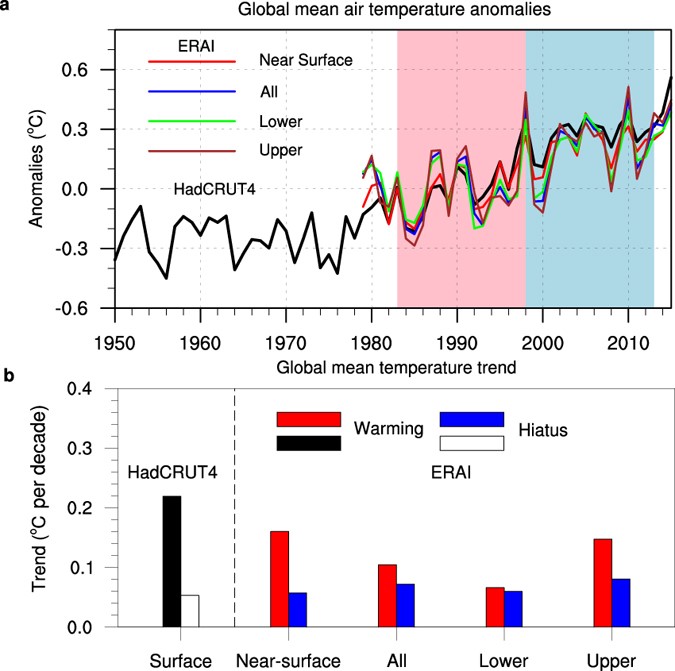博文
The Atmospheric Footprint of the Global Warming Hiatus
|
http://english.cas.cn/newsroom/research_news/201703/t20170301_174471.shtml
http://english.iap.cas.cn/RE/201702/t20170227_174390.html
New Study Reveals the Atmospheric Footprint of the Global Warming Hiatus
The increasing rate of the global mean surface temperature was reduced from 1998 to 2013, known as the global warming hiatus or pause. Great efforts have been devoted to the understanding of the cause. The proposed mechanisms include the internal variability of the coupled ocean-atmosphere system, the ocean heat uptake and redistribution, among many others. However, the atmospheric footprint of the recent warming hiatus has been less concerned. Both the dynamical and physical processes remain unclear.
In a recent paper published in Scientific Report, LIU Bo and ZHOU Tianjun from the Institute of Atmospheric Physics, Chinese Academy of Sciences have investigated the atmospheric anomalous features during the global warming hiatus period (1998-2013). They show evidences that the global mean tropospheric temperature also experienced a hiatus or pause (Fig. 1). To understand the physical processes that dominate the warming hiatus, they decomposed the total temperature trends into components due to processes related to surface albedo, water vapor, cloud, surface turbulent fluxes and atmospheric dynamics. The results demonstrated that the hiatus of near surface temperature warming trend is dominated by the decreasing surface latent heat flux compared with the preceding warming period, while the hiatus of upper tropospheric temperature is dominated by the cloud-related processes. Further analysis indicated that atmospheric dynamics are coupled with surface turbulent heat fluxes over lower troposphere and coupled with cloud processes over upper troposphere.

Figure 1. (a) Global mean temperature anomalies from 1950 to 2015 and (b) linear trends of global mean temperature for near surface (i.e. the lowest atmospheric layer), and the vertical average of the whole (surface to 100hPa), lower (surface to 500hPa), and upper troposphere (500hPa to 100hPa). Red (black) bars are for the warming period. Blue(white) bars are for the hiatus period. (Liu and Zhou, 2017)
As to why the surface latent heat flux, atmospheric dynamics and cloud-related processes showed such large differences between 1983-1998 and 1998-2013, LIU, the first author of the paper, explained, “They are dominated by the Hadley Circulation and Walker Circulation changes associated with the phase transition of Interdecadal Pacific Oscillation (IPO).” According to LIU, the IPO is a robust, recurring pattern of sea surface temperature anomalies at decadal time scale. During a positive phase of IPO, the west Pacific and the mid-latitude North Pacific becomes cooler and the tropical eastern ocean warms, while during a negative phase, the opposite pattern occurs. The IPO has shifted from the positive phase to negative phase since 1998/1999, and this transition has led to the weakening of both Hadley Circulation and Walker Circulation, which served as a hub linking the three processes mentioned above.
“Though the heat capacity of the atmosphere is nearly negligible compared with the ocean”, said ZHOU, the corresponding author of the paper, “understanding the atmospheric footprint is essential to gain a full picture of how internal climate variability such as IPO affects the global climate from the surface to the troposphere. The new findings also provide useful observational metrics for gauging climate model experiments that are designed to understand the mechanism of global warming hiatus”.
Citation: Liu, B. & Zhou, T. Atmospheric footprint of the recent warming slowdown. Sci. Rep.7, 40947 (2017). http://www.nature.com/articles/srep40947
Contact : ZHOU Tianjun, zhoutj@lasg.iap.ac.cn
(Liu and Zhou, 2017)
https://blog.sciencenet.cn/blog-39720-1036640.html
上一篇:气候模式预估的中国区域升温到达2度阈值的时间为何存在不确定性?
下一篇:全球变暖停滞期间对流层大气的变化